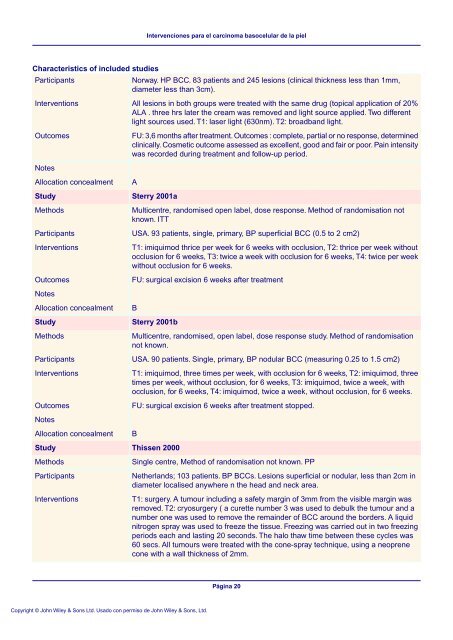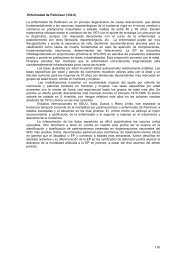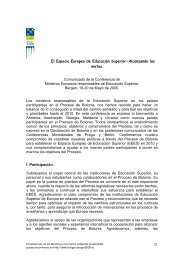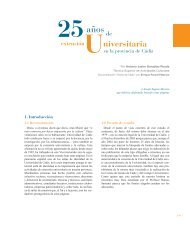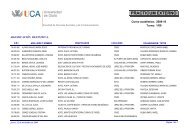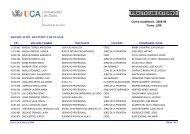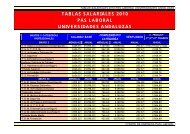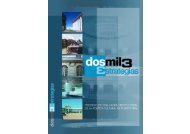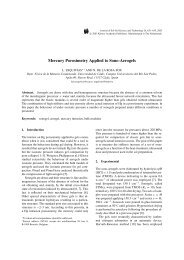Intervenciones para el carcinoma basocelular de la piel
Intervenciones para el carcinoma basocelular de la piel
Intervenciones para el carcinoma basocelular de la piel
Create successful ePaper yourself
Turn your PDF publications into a flip-book with our unique Google optimized e-Paper software.
Characteristics of inclu<strong>de</strong>d studies<br />
Participants<br />
Interventions<br />
Outcomes<br />
Notes<br />
Allocation concealment<br />
Study<br />
Methods<br />
Participants<br />
Interventions<br />
Outcomes<br />
Notes<br />
Allocation concealment<br />
Study<br />
Methods<br />
Participants<br />
Interventions<br />
Outcomes<br />
Notes<br />
Allocation concealment<br />
Study<br />
Methods<br />
Participants<br />
Interventions<br />
Norway. HP BCC. 83 patients and 245 lesions (clinical thickness less than 1mm,<br />
diameter less than 3cm).<br />
All lesions in both groups were treated with the same drug (topical application of 20%<br />
ALA . three hrs <strong>la</strong>ter the cream was removed and light source applied. Two different<br />
light sources used. T1: <strong>la</strong>ser light (630nm). T2: broadband light.<br />
FU: 3,6 months after treatment. Outcomes : complete, partial or no response, <strong>de</strong>termined<br />
clinically. Cosmetic outcome assessed as exc<strong>el</strong>lent, good and fair or poor. Pain intensity<br />
was recor<strong>de</strong>d during treatment and follow-up period.<br />
A<br />
Sterry 2001a<br />
Multicentre, randomised open <strong>la</strong>b<strong>el</strong>, dose response. Method of randomisation not<br />
known. ITT<br />
USA. 93 patients, single, primary, BP superficial BCC (0.5 to 2 cm2)<br />
T1: imiquimod thrice per week for 6 weeks with occlusion, T2: thrice per week without<br />
occlusion for 6 weeks, T3: twice a week with occlusion for 6 weeks, T4: twice per week<br />
without occlusion for 6 weeks.<br />
FU: surgical excision 6 weeks after treatment<br />
B<br />
Sterry 2001b<br />
Multicentre, randomised, open <strong>la</strong>b<strong>el</strong>, dose response study. Method of randomisation<br />
not known.<br />
USA. 90 patients. Single, primary, BP nodu<strong>la</strong>r BCC (measuring 0.25 to 1.5 cm2)<br />
T1: imiquimod, three times per week, with occlusion for 6 weeks, T2: imiquimod, three<br />
times per week, without occlusion, for 6 weeks, T3: imiquimod, twice a week, with<br />
occlusion, for 6 weeks, T4: imiquimod, twice a week, without occlusion, for 6 weeks.<br />
FU: surgical excision 6 weeks after treatment stopped.<br />
B<br />
Thissen 2000<br />
Copyright © John Wiley & Sons Ltd. Usado con permiso <strong>de</strong> John Wiley & Sons, Ltd.<br />
<strong>Intervenciones</strong> <strong>para</strong> <strong>el</strong> <strong>carcinoma</strong> basoc<strong>el</strong>u<strong>la</strong>r <strong>de</strong> <strong>la</strong> pi<strong>el</strong><br />
Single centre, Method of randomisation not known. PP<br />
Nether<strong>la</strong>nds; 103 patients. BP BCCs. Lesions superficial or nodu<strong>la</strong>r, less than 2cm in<br />
diameter localised anywhere n the head and neck area.<br />
T1: surgery. A tumour including a safety margin of 3mm from the visible margin was<br />
removed. T2: cryosurgery ( a curette number 3 was used to <strong>de</strong>bulk the tumour and a<br />
number one was used to remove the remain<strong>de</strong>r of BCC around the bor<strong>de</strong>rs. A liquid<br />
nitrogen spray was used to freeze the tissue. Freezing was carried out in two freezing<br />
periods each and <strong>la</strong>sting 20 seconds. The halo thaw time between these cycles was<br />
60 secs. All tumours were treated with the cone-spray technique, using a neoprene<br />
cone with a wall thickness of 2mm.<br />
Página 20


